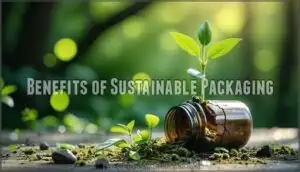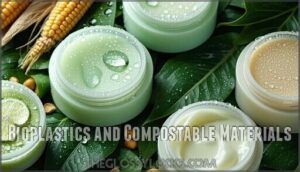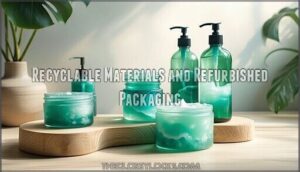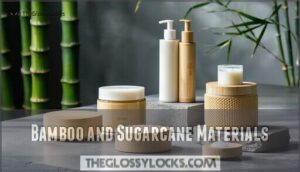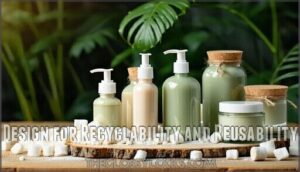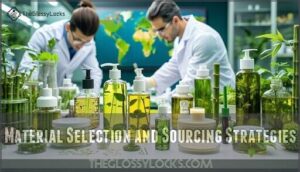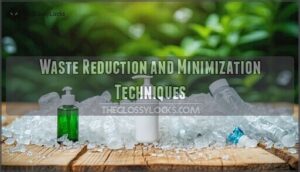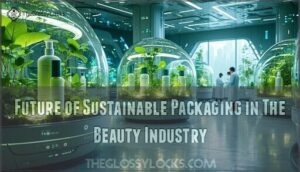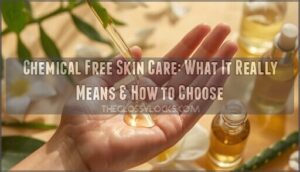This site is supported by our readers. We may earn a commission, at no cost to you, if you purchase through links.
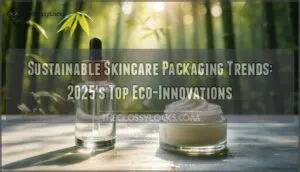 You’re seeing sustainable skincare packaging trends reshape the beauty industry in 2025. Brands are switching to bioplastics made from corn starch and bamboo materials that cut carbon footprints by up to 30%. Ocean-friendly packaging solutions address marine pollution while refillable containers create closed-loop systems.
You’re seeing sustainable skincare packaging trends reshape the beauty industry in 2025. Brands are switching to bioplastics made from corn starch and bamboo materials that cut carbon footprints by up to 30%. Ocean-friendly packaging solutions address marine pollution while refillable containers create closed-loop systems.
Consumer demand drives these changes, with 73% preferring eco-friendly options. Smart packaging with biodegradable films for masks and multi-pack formats reduce waste.
Companies aren’t just going green for show—they’re saving money through optimized supply chains and building customer loyalty. The shift from plastic pollution to plant-based alternatives is becoming the new standard, not just a trend.
Table Of Contents
- Key Takeaways
- Drivers of Sustainable Packaging
- Benefits of Sustainable Packaging
- Popular Sustainable Packaging Materials
- Implementation Strategies for Sustainable Packaging
- Future of Sustainable Packaging in The Beauty Industry
- Frequently Asked Questions (FAQs)
- What are sustainable skincare packaging trends in 2024?
- What is sustainable cosmetic packaging?
- Is sustainable skin care packaging a good idea in 2025?
- Which packaging trends reshape beauty in 2024?
- How is sustainable packaging reshaping the beauty industry?
- What is the future of sustainable beauty packaging?
- How sustainable is packaging for beauty?
- Why do brands use sustainable skincare packaging?
- What are the most popular cosmetic packaging trends for 2024?
- Is sustainability a trend in the skincare industry in 2024?
- Conclusion
Key Takeaways
- You’ll reduce your carbon footprint by up to 30% when switching to sustainable packaging materials like bioplastics made from corn starch and bamboo.
- You can build stronger customer loyalty since 73% of consumers prefer brands that demonstrate genuine environmental commitment through their packaging choices.
- You’ll save money through optimized supply chains, refill programs that cut material costs by 30%, and reduced waste disposal expenses.
- You’re seeing the future today as bioplastics, ocean-friendly materials, and refillable systems become industry standards rather than optional trends.
Drivers of Sustainable Packaging
You’re witnessing a packaging revolution driven by five key forces that reshape how skincare brands approach their containers and materials. Consumer demand for eco-friendly options, strict government regulations on plastic use, brand reputation concerns, environmental impact awareness, and growing plastic pollution consciousness create a perfect storm pushing companies toward sustainable solutions.
Consumer Demand for Eco-Friendly Options
You’re witnessing a fundamental shift in consumer behavior that’s revolutionizing skincare packaging. Eco-conscious consumers now demand transparency from brands, scrutinizing purchase intentions beyond product quality. This growing awareness has created a ripple effect across the beauty industry, with 73% of millennials willing to pay more for sustainable products.
Eco-conscious consumers now demand transparency from brands, with 73% of millennials willing to pay more for sustainable skincare packaging that proves environmental commitment beyond empty promises
Your expectations are driving real change:
- Brand transparency in sourcing and manufacturing processes
- Greenwashing concerns forcing authentic sustainability commitments
- Influencer impact amplifying eco-friendly messaging and awareness
- Consumer demand pushing innovation in sustainable skincare packaging
Companies can no longer rely on superficial green marketing. You’re demanding proof, not promises. This shift toward eco-friendly packaging reflects deeper values about environmental responsibility and authentic brand relationships.
Government Regulations on Plastic Use
Across the U.S., plastic bans are reshaping skincare packaging. Seven states have enacted Extended Producer Responsibility laws, making brands financially responsible for packaging waste. California mandates 25% recycled content by 2025, and PFAS restrictions take effect in January 2025.
These global packaging regulations and recycling mandates aren’t just compliance hurdles—they’re driving innovation. Regulatory compliance creates a level playing field where sustainable solutions become competitive advantages.
Several states are implementing laws for producer responsibility organizations.
Brand Reputation and Sustainability Efforts
Your brand’s reputation now depends on authentic sustainability efforts, not just marketing promises. Consumer perception shifts rapidly when greenwashing awareness reveals hollow eco-claims, making transparency matter more than ever for long-term value.
Today’s consumers research your sustainable skincare packaging choices before purchasing. They’re demanding proof behind your ecofriendly packaging initiatives, creating direct links between sustainability efforts and brand reputation success.
- Document ethical sourcing partnerships with third-party certifications and supply chain transparency
- Share measurable environmental impact data through lifecycle assessments and carbon footprint reports
- Engage consumers with behind-the-scenes content showing your packaging innovation process and material selection
- Partner with recognized environmental organizations to validate your sustainability claims and build credibility
- Respond quickly to consumer demand feedback by adapting packaging solutions and communicating changes openly
Environmental Impact of Packaging Waste
The Environmental Impact of Packaging Waste creates a cascade of ecological problems you can’t ignore. Plastic Waste generates significant Carbon Emissions during production and transport, while Landfill Overload occurs when 70% of beauty packaging ends up buried. Microplastic Pollution infiltrates marine ecosystems, affecting 633 species and contaminating food chains. Traditional packaging takes centuries for Waste Decomposition, causing persistent Ecosystem Disruption.
This environmental crisis drives brands toward Sustainable Packaging and Ecofriendly Packaging solutions that minimize long-term damage. Shockingly, 95% ends up in the trash, exacerbating the problem.
Growing Awareness of Plastic Pollution
You’ve likely noticed how plastic pollution headlines dominate news feeds, sparking widespread consumer behavior shifts toward sustainable skincare packaging. Microplastic concerns and documented ocean impact drive your purchasing decisions as environmental responsibility becomes non-negotiable.
Recycling limitations expose flawed waste management systems, pushing you toward ecofriendly options. This awareness creates market pressure for waste reduction solutions, transforming how brands approach packaging design and forcing innovation in biodegradable alternatives that align with your values.
Benefits of Sustainable Packaging
When you switch to sustainable packaging, you’ll cut your brand’s carbon footprint by up to 30% while reducing waste disposal costs substantially.
You’ll also build stronger customer trust, as 73% of consumers prefer brands that demonstrate genuine environmental commitment through their packaging choices.
Reduced Carbon Footprint
Sustainable skincare packaging dramatically cuts your carbon footprint through smart material choices and optimized supply chain operations. Manufacturing impact drops when brands use renewable energy and local sourcing. Transportation emissions shrink with lightweight, compact designs.
Your consumer behavior drives this shift—choosing sustainable packaging materials signals demand for eco-innovation. This waste reduction approach promotes the circular economy.
Cost Savings Through Reduced Waste
Beyond environmental benefits, waste reduction delivers measurable financial returns. Refill programs cut material costs by 30%, while optimized packaging and minimalist design reduce production expenses by 25%.
Efficient materials and circular economy practices create sustainable packaging solutions that boost your bottom line.
Cost efficiency through waste reduction ROI makes sustainable packaging a smart business investment.
Compliance With Environmental Regulations
Managing global regulations becomes straightforward when you implement sustainable packaging solutions early. Regulatory bodies worldwide are tightening packaging standards, making regulatory compliance essential for market access. Smart brands view compliance costs as investments rather than burdens.
Here’s how compliance protects your business:
- International laws now favor eco-friendly materials, opening new markets
- Auditing processes become smoother with documented sustainability efforts
- Global regulations reward brands that prioritize environmental impact reduction
Your proactive approach to sustainable packaging transforms regulatory hurdles into competitive advantages.
Enhanced Customer Loyalty and Trust
Meeting environmental regulations creates a foundation, but your real opportunity lies in building authentic connections with ecoconscious consumers. Sustainable skincare packaging becomes a powerful tool for enhanced brand loyalty when you align your brand value alignment with transparency communication and ethical sourcing practices. Using products with natural ingredients benefits both the user and the environment. Your commitment to sustainable packaging creates long-term relationships that transform buyers into advocates:
- 76% of consumers trust brands more with eco-friendly packaging choices
- Reusable containers drive 3x higher customer retention through positive brand image
- Sustainable design boosts social engagement by 45% among target demographics
- Community feedback programs increase consumer demand and loyalty by 60%
Popular Sustainable Packaging Materials
You’ll find that sustainable packaging materials have evolved far beyond basic recycled plastic, offering pioneering solutions that actually work for skincare brands.
From bioplastics made from algae to ocean-bound plastic containers, these materials help you reduce environmental impact while maintaining product quality and consumer appeal.
Bioplastics and Compostable Materials
Bioplastics made from corn starch and sugarcane are revolutionizing skincare containers. These biodegradable materials meet strict compostability standards, breaking down in industrial facilities within 180 days.
Bioplastic feedstocks like PLA offer excellent material durability while reducing carbon emissions by 75%. The biodegradation process aids circular economy goals.
Consumer perception increasingly favors these eco-friendly materials for sustainable skincare packaging. Some consumers also prefer packaging that incorporates natural anti-aging solutions for added value.
Recyclable Materials and Refurbished Packaging
Recyclable materials are revolutionizing beauty packaging through smart design and circular economy principles. Modern refurbished packaging systems create closed-loop recycling that transforms waste into premium containers.
These systems prove recycled packaging delivers quality while supporting environmental goals. Consider exploring options for recycled beauty containers to further improve sustainability.
- Material lifecycles extend through sophisticated recycling innovation technologies
- Refurbishing processes convert old containers into like-new packaging solutions
- Consumer education drives proper disposal and recycling participation rates
- Sustainable packaging materials reduce virgin plastic dependency by 60%
Bamboo and Sugarcane Materials
You’ll find bamboo and sugarcane materials leading sustainable skincare packaging innovations in 2025. Bamboo sourcing emphasizes rapid renewability, with exceptional material durability compared to traditional plastics. Sugarcane processing creates adaptable, biodegradable containers with impressive biodegradability rates.
These sustainable materials substantially reduce carbon footprint while maintaining luxury aesthetics. You can even find various bamboo packaging options online. Ecofriendly materials like these prove sustainable skincare packaging doesn’t sacrifice functionality for environmental responsibility.
Ocean-Friendly Packaging Solutions
While bamboo and sugarcane offer plant-based solutions, Ocean-Friendly Packaging addresses marine pollution directly. Brands are increasingly using Algae-Based Packaging and recycled materials from the Ocean Plastic Crisis, preventing 10 million tonnes of waste from entering oceans annually.
These Marine Biodegradability solutions also include Coral Reef Safe inks and Ocean Cleanup Tech innovations. Plastic Alternatives like seaweed films decompose harmlessly underwater, offering a sustainable option.
Additionally, Ocean-Friendly Materials support coastal communities through waste collection programs, creating Ocean-Friendly Alternatives that actively protect marine ecosystems.
Implementation Strategies for Sustainable Packaging
You can’t just switch to sustainable packaging overnight, but you can build a systematic approach that works. Start by mapping your current packaging systems, then prioritize changes based on cost, environmental impact, and consumer response data to create a roadmap that actually sticks.
Design for Recyclability and Reusability
Smart sustainable packaging design starts with material compatibility—choose mono-materials that recycling facilities can actually process. Consider local infrastructure needs when selecting materials. Build in disassembly design so consumers can easily separate components. Consumer education is essential—clear labeling helps people understand proper disposal.
Focus on extended lifespan through durable refillable packaging that customers want to keep using. To further reduce waste, consider sustainable options. This approach creates true reusability while supporting the circular economy through thoughtful design choices.
Closed-Loop Systems and Supply Chain Optimization
Beyond traditional recycling, Closed-Loop Systems transform how you manage packaging lifecycles. Waste Stream Mapping identifies recovery opportunities, while Reverse Logistics brings used containers back for reprocessing.
Supplier Collaboration creates fluid material flows, reducing emissions by 85%. Optimized Transportation and Circular Design Principles support true Circular Economy models.
Your Supply Chain Optimization becomes a Waste Reduction powerhouse through strategic partnerships.
Material Selection and Sourcing Strategies
Your material choices directly impact both environmental health and brand credibility. Sustainable Materials and Ethical Sourcing become your competitive advantage when customers expect accountability. Consider the Material lifecycle from extraction to disposal when evaluating PlantBased Packaging options. The principles of sustainable packaging also apply to organic hair products, which are gaining popularity.
Strategic sourcing centers on these priorities:
- Verify supply chain transparency to reduce carbon footprint risks
- Choose EcoFriendly Materials with certified Sustainable alternatives
- Partner with suppliers who share your Sustainable Skincare Packaging values
You’ll balance performance requirements with environmental responsibility.
Waste Reduction and Minimization Techniques
After selecting sustainable materials, you’ll need thorough waste reduction strategies. Start with waste audits to identify problem areas. Package redesign and material optimization cut excess packaging by 30-40%.
Refillable packaging systems and circular packaging models keep containers in use longer. Efficient logistics reduce shipping waste, while consumer education drives proper disposal.
Zerowaste initiatives and packaging efficiency improvements complete your sustainable transformation.
Collaboration With Suppliers and Stakeholders
Building strong Supplier Partnerships requires more than just placing orders. You need Stakeholder Engagement that creates Shared Responsibility for sustainability goals. Collaborative Innovation happens when you work together on eco-friendly solutions. Ethical Sourcing becomes easier with trusted partners who share your values.
Here’s how to build effective partnerships:
- Establish clear sustainability metrics and targets with suppliers
- Create joint research and development programs for new materials
- Implement Supply Chain Optimization through shared data systems
- Develop Closed-Loop Systems that benefit all parties
- Regular audits guarantee Increased Transparency and Accountability
These Sustainable Practices create win-win scenarios where everyone profits from going green.
Future of Sustainable Packaging in The Beauty Industry
You’re witnessing beauty brands transform their packaging strategies as circular economy principles and zero-waste goals reshape the entire industry.
Smart packaging technologies, biodegradable innovations, and transparent supply chains aren’t just trends—they’re becoming the new standard for companies that want to stay competitive in 2025’s eco-conscious market.
Emerging Trends and Innovations
Smart packaging integrates sensors that monitor freshness, while QR codes connect you to tailored tutorials. This technology enhances consumer engagement through digital experiences.
Biomimicry design mirrors natural solutions using biodegradable materials. Refillable packaging and PCR materials support zero-waste goals.
Waterless beauty products eliminate plastic containers, with the market reaching $24.78 billion by 2033.
Circular Economy and Zero-Waste Goals
The circular economy transforms how you buy skincare by creating closed-loop innovation systems. Brands now design products with product lifecycle design thinking, ensuring waste stream reduction from start to finish.
Extended producer responsibility means companies take ownership of packaging disposal. Resource loop optimization turns your empty containers into new products through refillable packaging and compostable materials, achieving true zero-waste goals.
This aligns with the growing trend of organic hair products that prioritize safety and environmental responsibility.
New Technologies and Materials in Development
Pioneering Biomaterial Innovations are reshaping sustainable skincare packaging through innovative technologies. You’ll discover Mycelium Materials creating containers that decompose naturally, while Algae Packaging transforms ocean waste into protective barriers. Smart Packaging now monitors freshness using biosensors, and Edible Films offer zero-waste solutions.
Here are five game-changing developments:
- Algae-based Packaging converts seaweed into biodegradable containers
- Plantbased Packaging Materials from cornstarch create compostable tubes
- Mycelium Materials grow mushroom-root containers in weeks
- Smart Packaging integrates NFC chips for product traceability
- Edible Films dissolve harmlessly after use
These Biodegradable Materials and Compostable Materials represent current trends in Sustainable Skincare Packaging.
Increased Transparency and Accountability
You’re witnessing a packaging revolution where transparent labeling and third-party certifications replace empty promises. Supply chain visibility now lets you trace ingredients from farm to face cream.
Ethical skincare packaging companies showcase ingredient sourcing ethics through clear labeling practices and ecolabels.
Waste management reporting builds trust, while verified sustainable packaging claims eliminate greenwashing concerns.
Growing Demand for Sustainable Packaging Solutions
Your demand for sustainable skincare packaging drives remarkable market growth. Consumer behavior reflects ethical consumption patterns, pushing brand innovation toward ecofriendly packaging solutions.
Future projections show refillable packaging and biodegradable materials becoming standard. Companies adopting sustainable packaging solutions now will capture tomorrow’s environmentally conscious consumers.
Frequently Asked Questions (FAQs)
What are sustainable skincare packaging trends in 2024?
Packaging’s gotten a sustainability makeover that’d make your grandma’s mason jar collection jealous. You’ll see refillable containers, biodegradable materials, and glass bottles replacing plastic.
Waterless packaging and plant-based materials lead the charge toward eco-friendly beauty.
What is sustainable cosmetic packaging?
Sustainable cosmetic packaging uses eco-friendly materials like recycled plastics, biodegradable components, and refillable containers.
You’ll find brands prioritizing reduced waste, minimal design, and materials that break down naturally or support circular economy principles.
Is sustainable skin care packaging a good idea in 2025?
Like a town crier announcing the future, you’d be wise to embrace eco-friendly options. Market data shows skincare packaging reaching $32 billion by 2025 , with brands increasingly choosing recyclable materials and refillable containers.
Which packaging trends reshape beauty in 2024?
You’ll see minimalist designs, refillable containers, and smart packaging with tech features leading 2024’s beauty revolution. Brands embrace clean lines and functionality.
How is sustainable packaging reshaping the beauty industry?
Ironically, while we toss beauty products in plastic containers daily, nearly 80% of beauty brands will prioritize sustainable packaging this year.
You’re witnessing refillable containers and compostable materials replacing traditional plastic waste completely.
What is the future of sustainable beauty packaging?
You’ll see smart tech, biodegradable materials, and refillable designs transform beauty packaging. Bio-based plastics, bamboo, and compostable alternatives are replacing traditional materials.
Expect zero-waste solutions and transparent sustainability commitments to drive consumer loyalty.
How sustainable is packaging for beauty?
Beauty packaging walks a tightrope between progress and problems. You’re seeing real change: 64% increase in searches for refillable options and 69% of consumers expect sustainable packaging by
Why do brands use sustainable skincare packaging?
Brands choose sustainable skincare packaging because you’ll reward their environmental responsibility with loyalty. It reduces environmental impact, appeals to eco-conscious consumers, and enhances brand reputation. Smart business meets planet protection.
What are the most popular cosmetic packaging trends for 2024?
You’ll love 2024’s hottest cosmetic packaging trends: minimalist designs with clean lines, sustainable eco-friendly materials, refillable containers , and recyclability incentives that reward conscious consumers.
Is sustainability a trend in the skincare industry in 2024?
Yes, sustainability’s a major trend you can’t ignore in 67% of consumers seek out sustainable beauty products, pushing brands toward eco-friendly formulas and greener practices to meet demand.
Conclusion
Like medieval alchemists turning lead into gold, you’re witnessing sustainable skincare packaging trends transform beauty’s environmental impact. These innovations cut carbon emissions by 30% while building stronger customer relationships.
You’ll see bioplastics, refillable systems, and ocean-friendly materials become industry standards.
Smart implementation through closed-loop systems and supplier collaboration drives both profitability and planet protection. The data’s clear: sustainable packaging isn’t tomorrow’s possibility—it’s today’s competitive advantage.
- https://meyers.com/meyers-blog/sustainable-beauty-packaging-industry-trends-opportunities/
- https://www.containerandpackaging.com/resources/5-Trends-in-Sustainable-Cosmetic-Packaging
- https://makersrow.com/blog/sustainable-beauty-packaging-skincare-packaging/
- https://www.4ocean.com/blogs/industry-news/from-plastic-jars-to-eco-friendly-containers-a-look-at-sustainable-skincare-packaging
- https://www.woola.io/blog/cosmetic-packaging-waste-statistics

